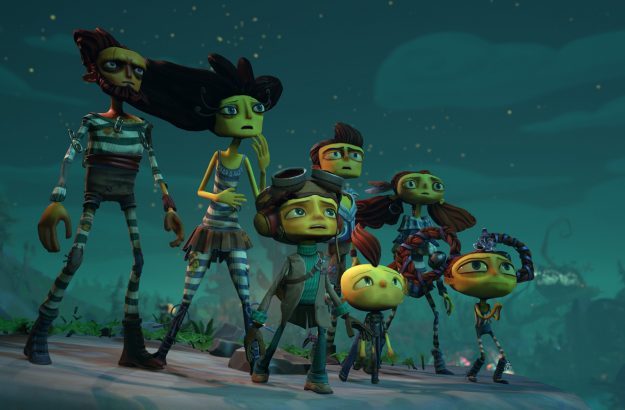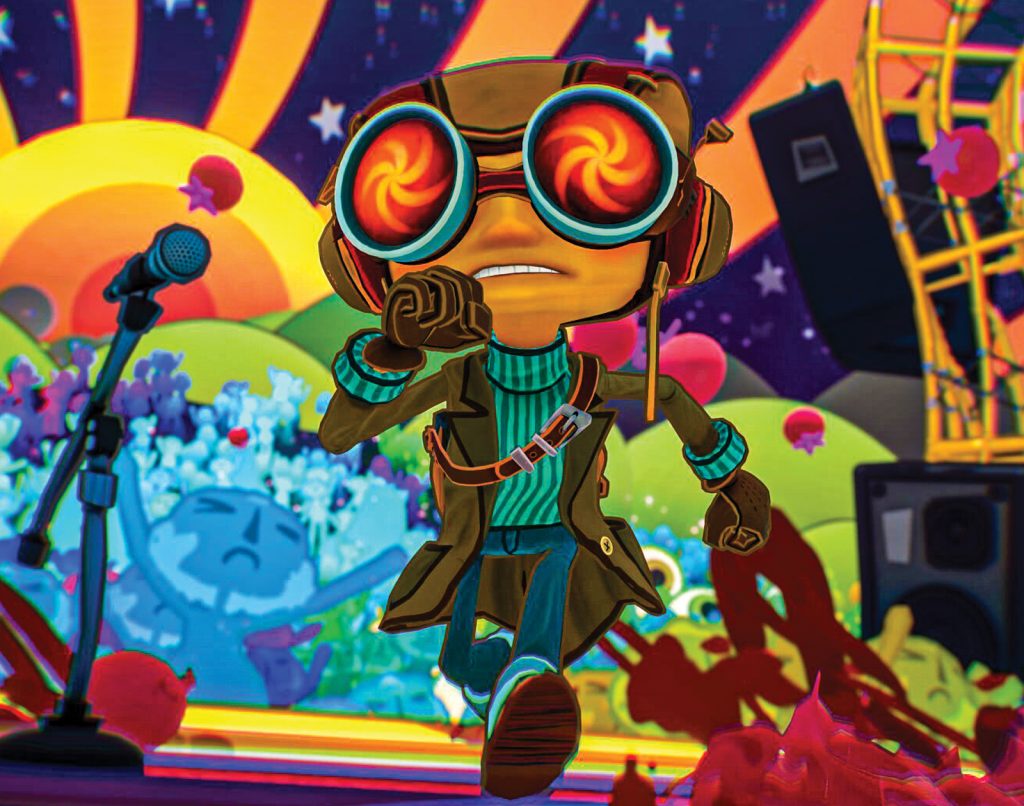When the psychic spy adventure Psychonauts was released in 2005, the big-budget game was not very popular, with its then-publisher, Majesco Entertainment, taking a major financial hit. But despite initially poor sales the title attracted critical praise, numerous awards, and a devoted fan base—which resulted in a massive spike in sales nearly a decade later when the game became available for digital download. This belated success recently resulted in the release of Psychonauts 2, a whimsical exploration of a subject at the center of Buddhist thought: suffering.
Psychonauts’s mental saboteurs are essentially meditators turned outward. Through deep concentration, they delve into the minds of suffering individuals, traversing the latter’s metaphor-laden inner worlds, slaying their inner censors, and sorting through literal mental baggage (a sobbing suitcase or downtrodden duffle, for example). This is not a game that wears its Buddhist influences on its sleeve—its creator Tim Schafer has described it as Jungian, if anything—but there are hints of the dharma throughout the narrative: the Psychonauts meditate on cushions, one character is clearly modeled on Allen Ginsberg, and there is a sense of roving, mindfulness-like awareness throughout the game. Indeed, it’s dissolving the illusions of self that often stands at the heart of Psychonauts 2.
The game explores, time and again, how the narratives about ourselves that we carry around never fully encompass what it is to be a conscious being. Its levels play as symbolic manifestations of various characters’ hang-ups, humiliating secrets, and most wrenching disappointments. An old man plagued by loneliness might imagine himself stranded on a psychic desert island, marooned by memories of a painful childhood and separated from friends by oceans of his own inadequacy. Yet these stories, these attempts to create an unmoving monolith to represent our experience, inevitably fail to tell the whole truth.
The psychic spy adventure is a whimsical exploration of a subject at the center of Buddhist thought: suffering.
As we venture through the game’s levels—grand psychic set pieces demonstrating each character’s metaphor of self—we are nagged by the sense that something is not quite right about them: The stories seem off. When we enter the mind of a gambling-addicted doctor, for example, we can’t help but ask, “Why is there a casino in this dilapidated hospital?” Inside the mind of a jaded romantic, we question, “Is this unsent love letter really so important, so terrifying, that it needs to be hidden under a literal tornado of mail?” Eventually we discover that these scenes have their own dream logic that reflects the dreamers’ mental hang-ups but certainly not reality.
Of course, the player can see through these flimsy narratives. But the game’s isolated characters live inside their own vacuums, unpenetrated by the probing light of awareness. Because of this, they are stuck within the stories they’ve too long told themselves; left clinging to their past experiences for guidance, they fail to see—as the psychologist and mindfulness writer Arnold Kozak puts it—that “no moment of self wholly equals another.”
This is the brilliant truth illuminated by Psychonauts 2. We eventually see all of these unmoving inner universes as the prisons they are and understand how awareness can move us toward a more flowing and loving conception of what it is to be.

That’s the potential inherent in video games: We, the players, are always present, participating in the proceedings. One could argue that our role in Psychonauts 2 is nothing less than awareness itself.
Pervading the game is the sobering sense that we are behind the scenes on a theme park ride, looking around on a psychic backlot where we shouldn’t quite be. The same experience can arise in meditation. We become aware of a repetitive pattern of thought or a particular emotional reaction we’ve carried around for years, and we think, “How have I never looked directly at this before? And what made me cling so closely to it?”
Much of the game’s emotional depth comes from this sudden awareness of something lacking, some greater emptiness within these mental worlds. We have the poignant sense that we are seeing some source of great pain that not even the sufferer knows about. In a sense, this arises because we are peeking behind the veil of the illusion of self. These mental spaces—where mindless habits and circular narratives have too often dominated—are being exposed to our awareness, and awareness finds them to be lacking. In this way, the game raises the question of what happens when we just observe the self closely, bringing to mind Chan master Hsu Yun’s famous meditation prompt: “Who drags your corpse around?”
What, in other words, has been shouldering the great burden of sensation, attachment, suffering all along? It is the self. But when we look at the self directly, in the right light, the entire facade collapses like a house of cards.
Thank you for subscribing to Tricycle! As a nonprofit, we depend on readers like you to keep Buddhist teachings and practices widely available.
